Regionale 19
Liquid Planet: Abstract Painting Today
25.11.2018 —
7.1.2019
How powerful and contemporary do we believe painting is today? How much relevance or presence do we accord it? At the Kunsthaus Baselland this year’s Regionale exhibition presents 20 artists of different generations from the tri-national region. In their work all the artists focus on non-representational painting and thus negotiate possibilities for an ongoing and relevant painting practice.
The selected and invited artists will predominantly exhibit large-format presentations of several works.
Parallel to this group exhibition artists Muda Mathis, Sus Zwick and Hipp Mathi show their new work L’univers de Germaine – a three-part video project which looks at 82-year old Germaine Winterberg, an exceptional, well-travelled Basel figure – in the Kunsthaus Annex.
For further information please visit:
regionale.org
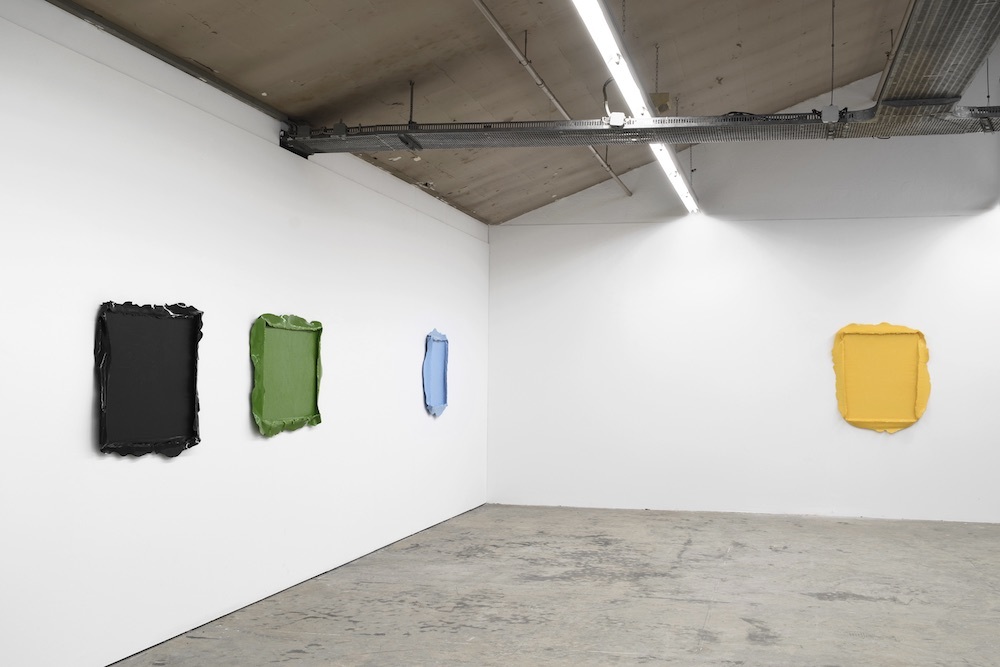
In her series The closest I could get Anna Amadio (b. 1963 in Belp, lives and works in Basel) moves as near as possible to painting — in an unusual manner. ‘Every picture absorbs space too, which is often forgotten, because it seems so slight,’ says the artist. In her series Amadio examines this space that is part of the painting. By tracing how paint was applied in key works from art history, or, to be precise, repainting them, layer by layer, with exactly the same brush size and the same characteristics, Amadio achieves an intensive haptic dialogue with her subject. In a subsequent step Amadio pours acrylic colour over the finely painted landscapes, paint in colours derived from the original pictures. She then pulls this colourful acrylic skin off its support and in the process reveals the negative — and the picture’s space. Amadio releases painting from its common denominator, that it is recognisable, and enables a kind of look behind the scenes. In her works she considers where picture and space meet, and painting and sculpture, and in so doing translates masterpieces from art history into contemporary dialogue.
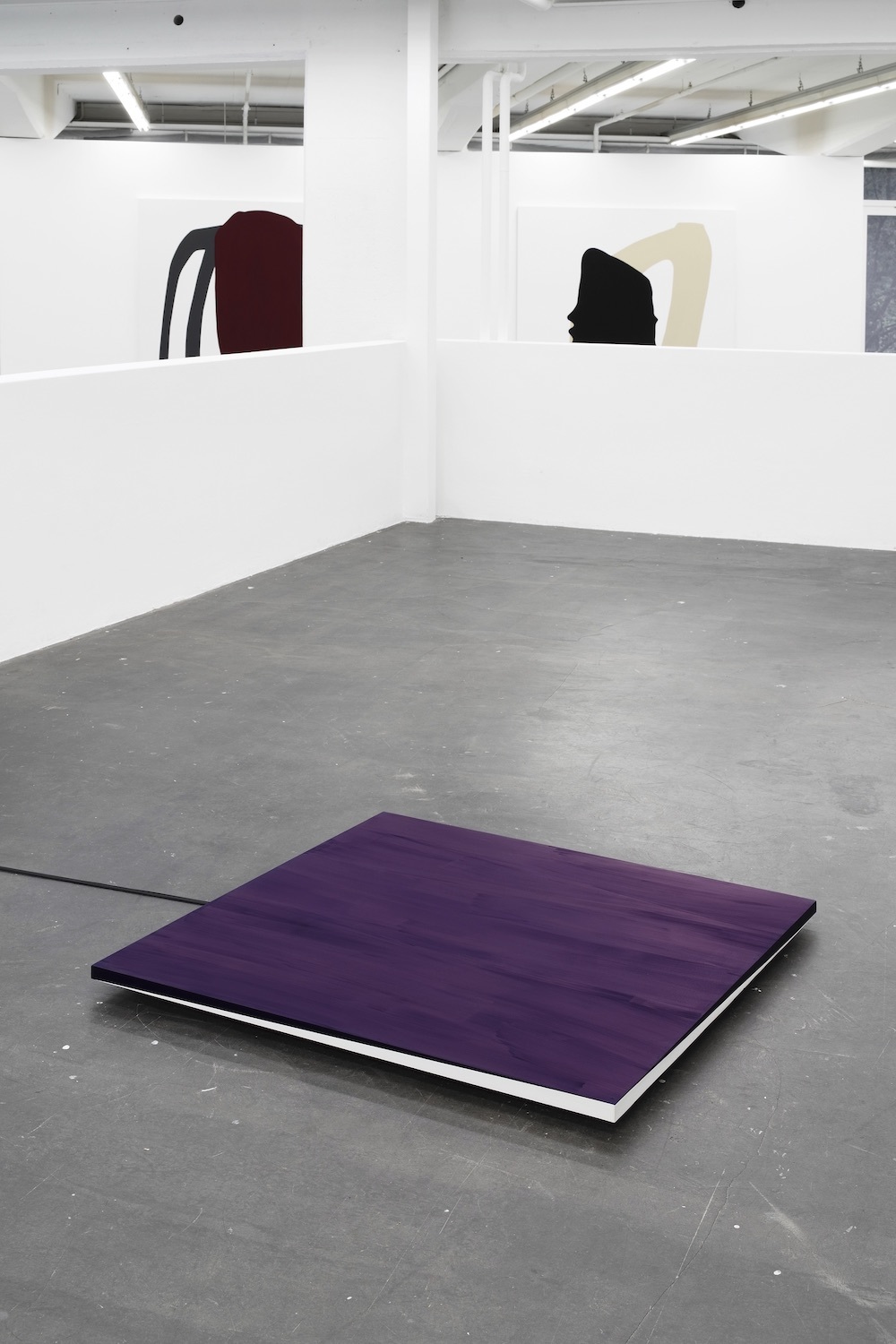
Anja Braun (b. 1985 in Freiburg in B., lives and works in Basel) defines her work as ‘painting in an extended field’. She has a single work at the Kunsthaus Baselland for Regionale 19, a work which, on one hand, accords with monochrome painting, yet is, on the other, a sculpture and installation. A violet surface with a colour that appears to change, opalescing slightly as natural light falls upon it. The painted concrete form also functions as a sound box. Delicate noises are transmitted to the concrete through resonators and gain a distinctive tone there: burbling water and various other voices from nature are emitted from the painterly object. Through this ‘sonorous painting’ Braun achieves a moment of direct encounter between the object and its viewer. This very combination of form, colour and sound makes the appeal, the almost seductive nature of the work. The work emits calm, yet striking power and presence too.
For some time Anja Braun has engaged intensively with the forms, materials, surfaces and energy of painting. Through sound she lends her objects their own voice and aura. Braun describes herself as coming from painting, though she does not limit herself to one medium. “I can paint with video just as I can with paint and brush.” Her fundamental interest remains a fascination for the auratic and illusion, as well as investigation of form and colour. (KF)
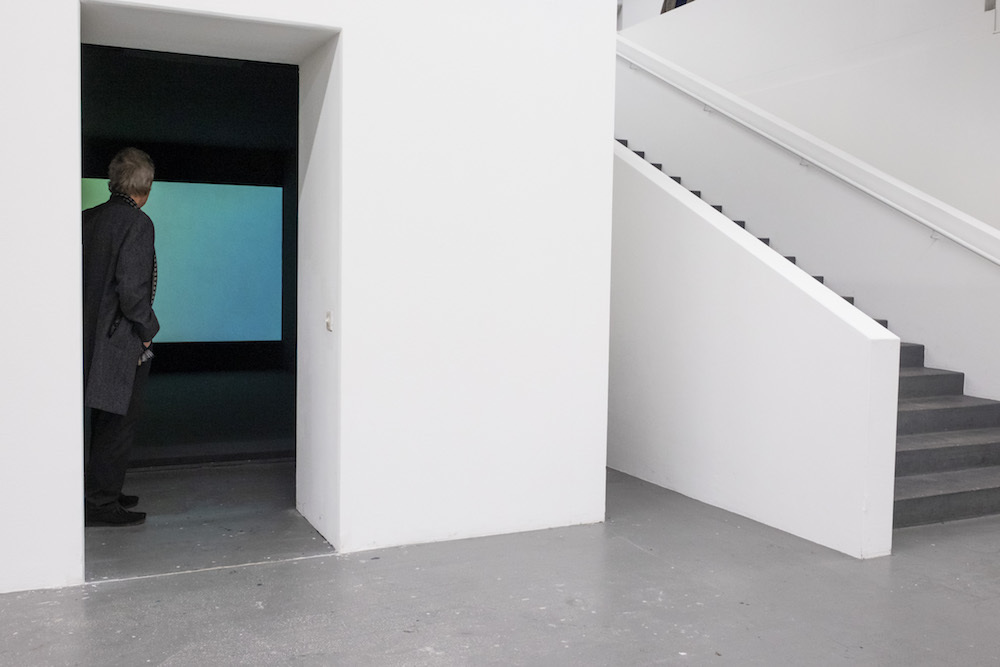
Emma Cozzani’s (b.1989 in Ajaccio, lives and works in Strasbourg) approach creates a point where the three dimensions of image, space and language meet. Her video work Out of the Blue from 2016 dives into colour which is continually flowing. Her starting point is the idea that any absence of visual stimulation leads to a series of lively, bright and multicoloured hallucinations in viewers. Cozzani’s references to literature and fiction become clear when a third voice emerges alongside a dialogue between two fictional characters. Her characters are looking for new ways of speaking and seeing. The forms conjured by the artist reflect the delicate relationship with reality on the margins of fiction. (IT)
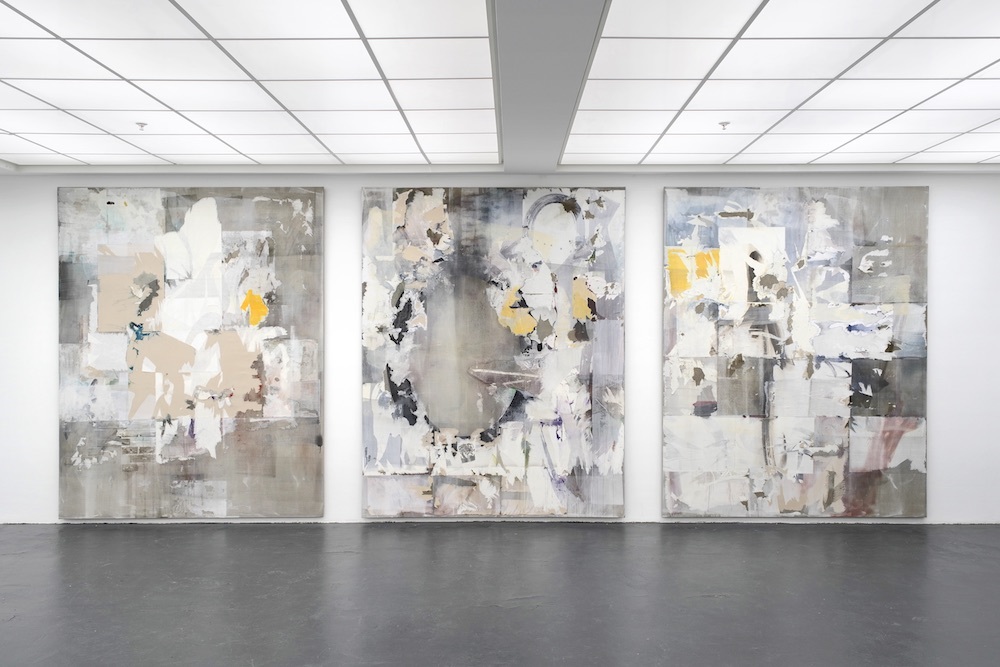
Basel-based artist Adrian Falkner (b. 1979 in Liestal, lives and works in Basel) engages methodically with the subject of surface. In his most recent series he challenges the surface as carrier and as material. The work’s poetic title Abandoned already offers an indication of the subject matter. The paintings, with their orphaned air, are made of layers of canvas, ripped paper and soft paint tones. An era coming to a close or a past time are tangible through these fragments and colours. Yet in his three works Falkner also deals with quite another interface. By choosing a surface which is raw, not perfect, marked by paper fragments as his working material, the artist engenders a new dialogue between graffiti and painting. Graffiti is significantly marked by the background on which it is made: the bare surface of plaster, many-layered poster sites and corrugated metal casings are used and appropriated – the affichistes’ provocative way of working was similar. Adrian Falkner makes the problematic of the White Cube his topic, the unformed, characterless superficial surfaces of a traditional exhibition space. Being an artist also active in the graffiti scene Falkner finds a painterly way to direct a discourse on the question of graffiti art in an exhibition context by making the surface the content of his paintings, distinguishing these not through provocation but by attributing them a past. (KF)
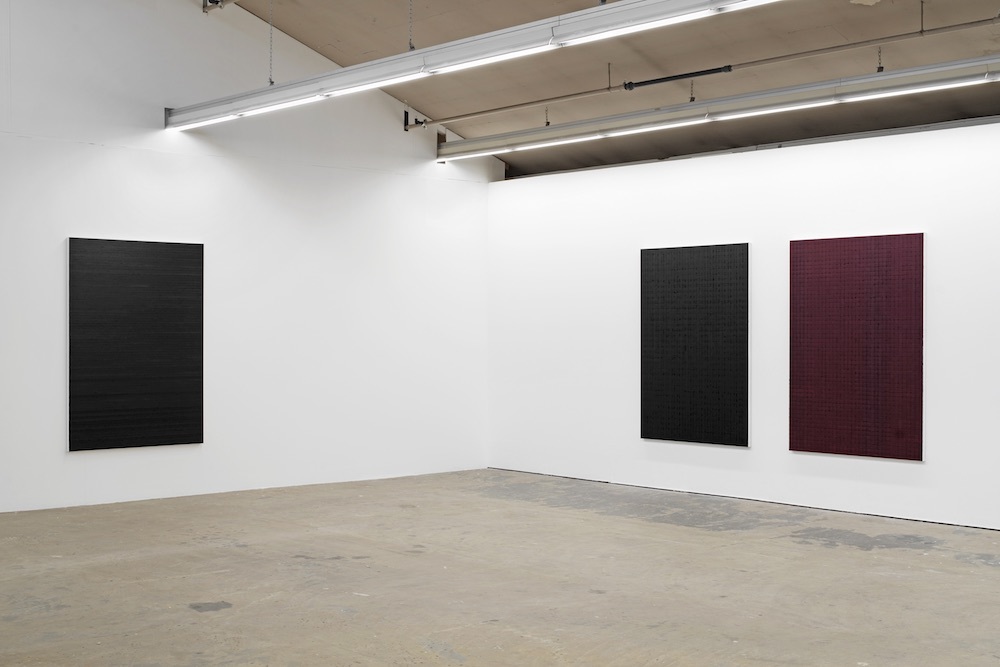
Corsin Fontana (b. 1944 in Chur, lives and works in Basel) is not interested in effects in his painting. Using a time-consuming process and large amounts of oil pastel — specific pressed cylindrical sticks of linseed oil and colour pigment — horizontal or vertical lines and grids are drawn and pressed onto the stretched canvas. The maximum size of the work accords with the artist’s own dimensions and at the same time expresses something about moderation in his painting. No effects, yet a sometimes-painterly application of the individual lines which, depending on how the oil pastel is cut, may produce wider or narrower tracks. Usually there is just a single layer of a stripe structure placed on the canvas, creating an astonishing result in the process. The pressure on the oil pastels that Fontana generally employs in muted colours and tones also changes the ridges which accumulate on the sides; the artist speaks of “brewing” to describe the almost landscape-like relief of his paintings. This relief generates light and shadow; the question of existence is inherent in his painting. The oil pastel drawings and paintings that emerge this way are fascinating not only for the contemporaneousness of ground, applied structure and a surface that, if light falls evenly upon it, vibrates gently. They are also fascinating because they express what abstract painting can achieve — the highest degree of presence in space, even with reduced means. (IG)
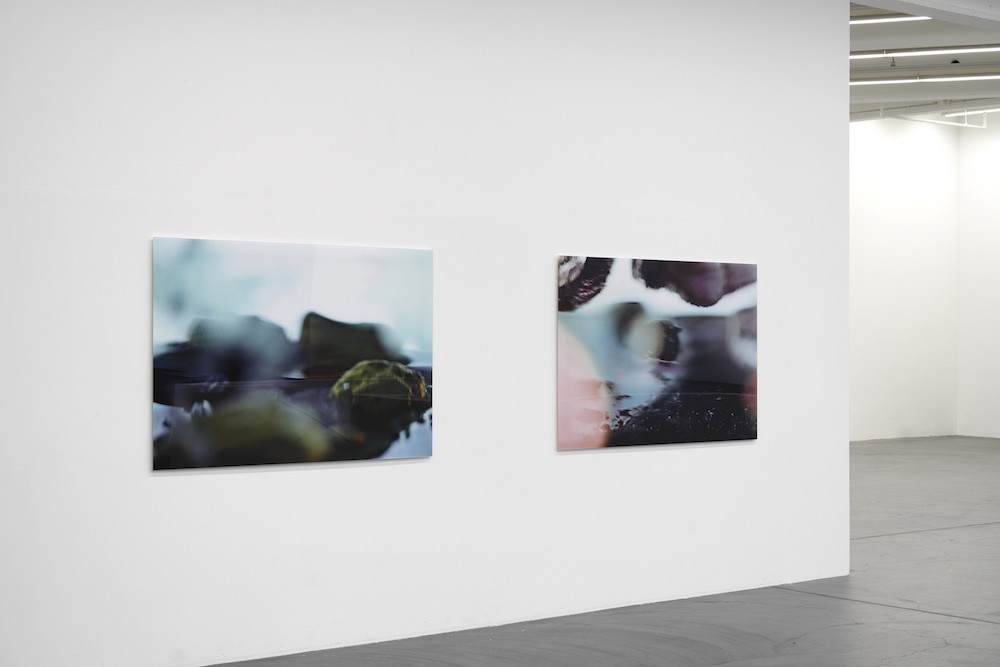
Abstract painting using photography as medium? Painterly photography? Katrin Freisager (b. 1960 in Zurich, lives and works in Zurich and Basel) does both these things. Her photographs, which appear attractive and yet cryptic, demonstrate a new direction for painting today to follow. In her initial process Freisager mixes various oils, colour pigments or even inks and applies these to glass surfaces, or mixes them into surprising combinations in water cylinders – not unlike a painter’s process. Only then is the result correctly illuminated and she reaches for the camera. Focussing close-up on the deposits of pigment and water created this way, the artist finds extraordinary depth of field and details therein. Akin to an alchemist, Freisager conjures landscapes for us that seem to evade precise description, yet have the ability to evoke memories and feelings of places or situations, while still being purely abstract pictures. (IG)

Anja Ganster (b. 1968 in Mainz, lives in Binningen, BL) finds her way to abstraction through framing and reduction. For many years she has been carefully challenging the relationship between the object world and individual perception, which is constantly in flux. Ganster is led by light and shade as form-giving entities; applying various techniques multi-faceted large and small-format painting emerges. A central foundation for her work is her travel in foreign countries and the associated reassessment of inner and outer states. Doing this, the artist is not aiming to illustrate specific places, but instead to express an absorbing, atmospheric reality. Ganster extracts the objects presented from their spatial contexts and thus draws the personal, continually reconstituting act of seeing into the foreground. (CA)
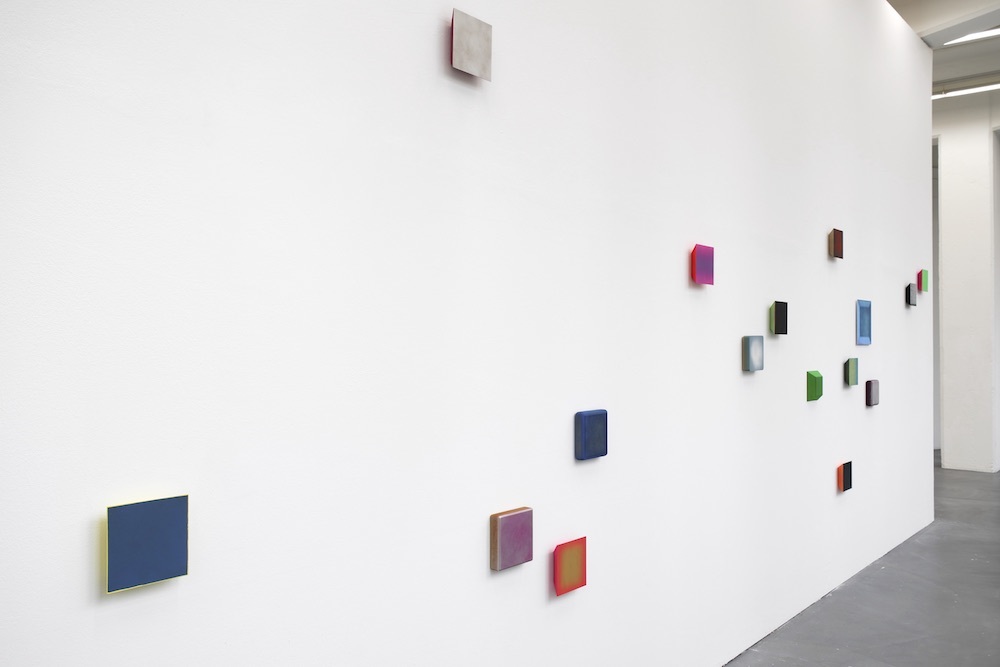
The works shown here from the ongoing series Quadratbild (Square Picture) by Gert Handschin (b. 1959 in Basel, lives and works in Basel) are made on MDF board several centimetres thick, their edges measuring only 17 cm. Through work on the edges and application of widely varied colours in multiple layers the artist realises a variety of sculptural structures on what were once identical panels, images which vary widely in their spatial effect.
A play on optical illusion marks Handschin’s work. He allows spaces to form from the flat surface, or manipulates it through cleverly judged interventions. In earlier works, which often play with the tension between two-dimensionality and sculpture, he was already using painting as method. The Quadratbild series, however, shows this more obviously and with a clearly visible painterly gesture with which the artist playfully challenges the subject of serial production.
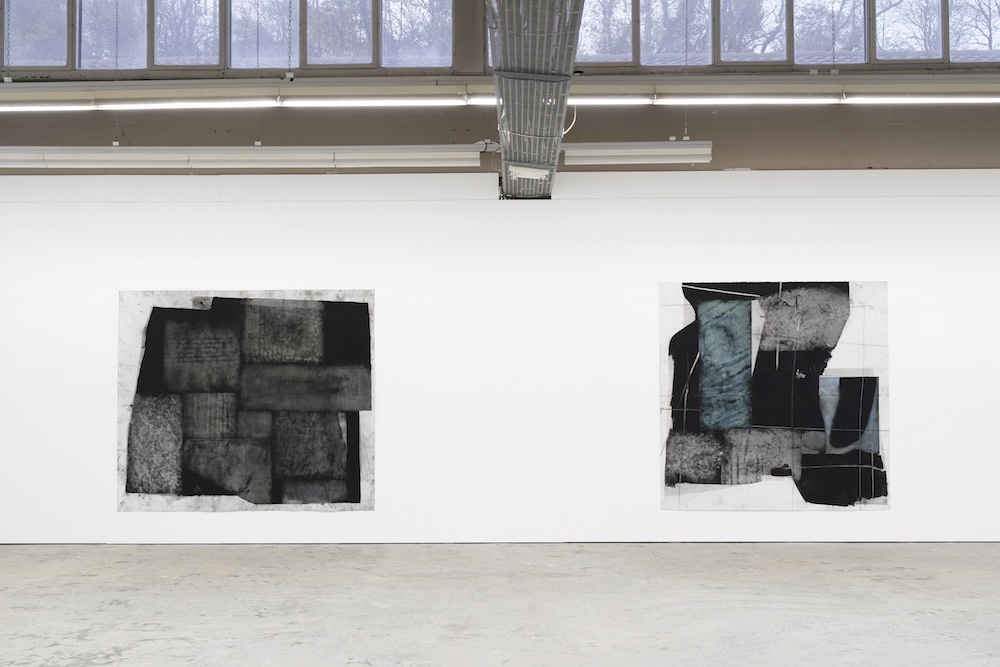
As part of Regionale 19 the Kunsthaus Baselland shows two large-format works by Thomas Hauri (b. 1974 in Menziken, lives and works in Basel) which mark a new direction in his practice. He uses the technique of negative frottage in his 2018 work Ohne Titel (Untitled). He has chosen this term himself to emphasise the contrast with customary frottage, not applying colour to white paper but washing dark colour away. Initially Hauri applies several layers of colour, culminating in black. He then takes the paper into the open for a first removal. Within selected fields he works over the paper on top of tarmacked ground with a brush. When the black colour thus dislodged is washed away there is a moment of image creation unforeseen even by the artist. The work is reminiscent of x-ray images of architectural structures thanks to how the lower layers seem to ‘light through’ the picture. (IT)

Hanspeter Hofmann (b. 1960 in Mitlödi, lives in Binningen, works in Basel) works in cumulatively developing series and processes. There can be sustained phases in which a new work may emerge out of another’s creative process or, ultimately, be rejected. The detail of one structure, linear form or image, often reminiscent of an abstract organism, becomes the main subject of another. A variety of formats create new pictorial emphases. In a method like that of scientific research Hofmann challenges the micro and macrocosm of being-in-the-world through often large-scale works. There is continual shifting between organic-seeming structures and pictorial elements like skulls, text, birds and monkeys etc. which break the abstract structure. ‘Science Pop’ might be the new term for this. His strategic design process develops meaning within a powerful pictorial language that is sometimes akin to medical illustration, just as it does through accident and reflexive creation within the process. For Hofmann this artistic approach is a means of gaining knowledge which he tries to transmit to the viewer, a means of wanting and being able to explain and understand, without compromising sensory experience.
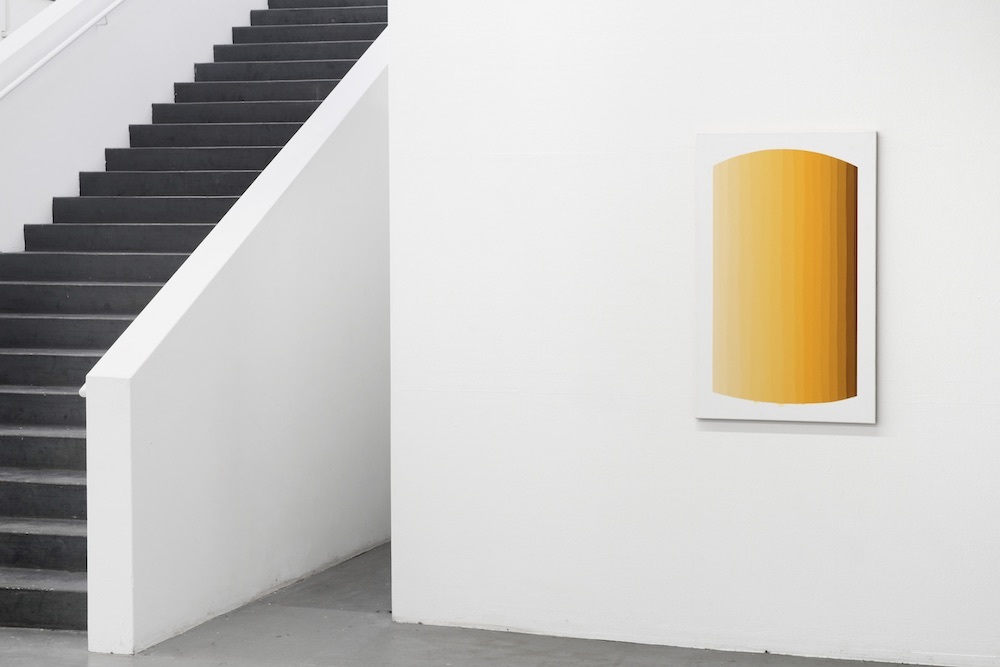
Matthias Huber (b. 1980, Bottmingen, lives and works in Basel) engages with questions of visualisation. His subjects can be abstract, figurative or concrete, or they can appear like studies in form and colour. His studio reminds one of an extensive classification system in which the artist collects and archives in paint. It seems as though Huber coaxes all the possibilities from a tone — the colour he mixes with pigment can, for example, be layered to a rectangle on a small canvas, be found in an abstract form within a large-scale work, or, indeed, become a figure like an animal or object. For Huber painting is just this: ordering a multi-layered archive of images, forms and colours. Yet this artistic, theoretical approach does not hinder sensual enjoyment. For behind every visualisation lies Huber’s keen sense of the emotional and spatial effect which may be catalysed in the viewer.

The work Wasserfall (Waterfall) marks a new phase of Kwanyoung Jung’s (b. 1974 Seoul, lives and works in Karlsruhe) work. While the central element in his work was previously utopian space, Jung now begins to explore this space. The lines with which he constructed his spatial images are liberated and can find their own form. “I’ve always created spaces and examined and formed these through linear structures. Now one question is central: what is in these spaces – maybe a waterfall?” Through the technique chosen the dynamic of the strictly linear images is disrupted. Through application, working in and removal of gouache on stone paper a unique colouring occurs that enables the waterfall to appear lively and mutable. Jung sees his abstract language of form as a possibility of creating space for a different world where different rules can have effect. He works on his world methodically and meticulously, with unexpected and surprising elements as key tools in his work. (KF)
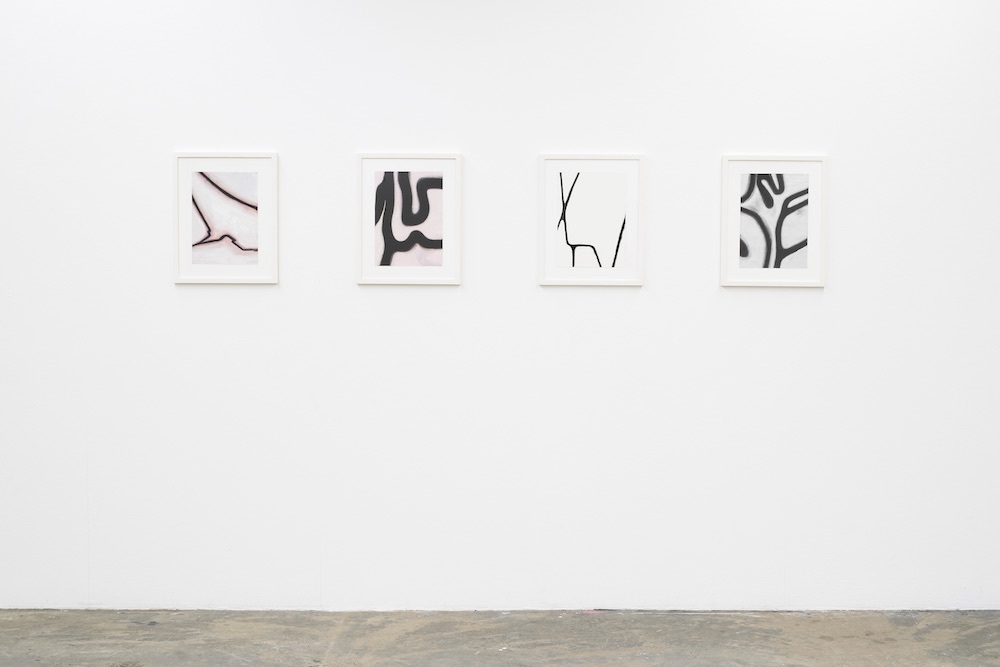
Where does an artistic process start? Where does a picture, a painting or a drawing begin? How can a surface be designed, or its edges defined? How far back can we trace materials, how much honesty do they allow? Emil Michael Klein (b. 1982 in Zurich, lives and works in Zurich) generally starts his paintings where others complete the process — with the signature. The whole large-scale surface is organised starting there, ultimately creating a monochrome painting with three letters as its painterly spine: EMK. Or, instead, he starts with shapes which he applies in oil paint to the canvas, in thin layers, spread liberally around the picture. He is interested in the linear forms that occur where they meet and in the coming together. These forms are marked with more oil colour, worked out, covered, remade, and can be realised thickly or in just one or two linear marks. Soft pencil lines become visible and reveal the artistic process. The searching painter reveals his struggle? It is indeed the revelation of a process which does not occur in a linear fashion but which instead only starts to make sense for those of us who cannot pick up paintbrush and canvas through these reversals, re-seeing and re-thinking. (IG)
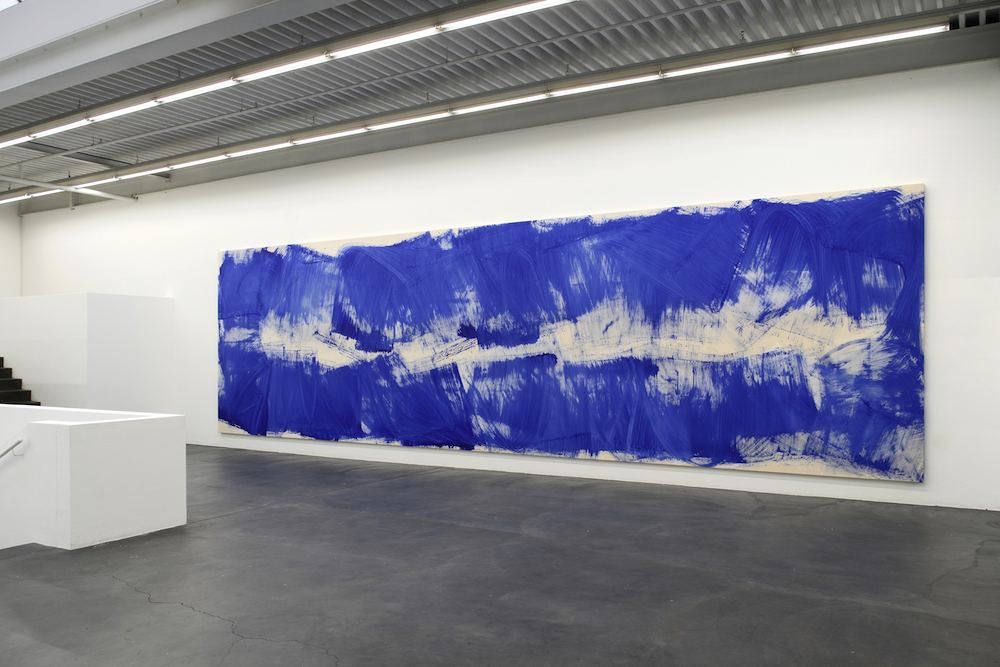
Renée Levi’s (b. 1960 Istanbul, lives and works in Basel) work extends over so many metres along the wall of the Kunsthaus Baselland that it could equally be a mural. In fact, the size accords with a standard trade format for cotton cloth. Levi is interested in the space as a place, or equally the space as another two-dimensional surface, which can be transformed through a swiftly-applied gesture — painted or sprayed — that may attract the viewer. For Levi painting is above all an offer: the offer to live together and to open oneself up to the painting, not just visually but also physically and emotionally. Her painting surrounds the viewer like a force field, not trying to explain or intellectualise. She understands her paintings, which are usually created at great speed and with great physical involvement, as an invitation to the viewer to allow themselves to be dragged along and activated — and, ideally, to become active too. (IG)
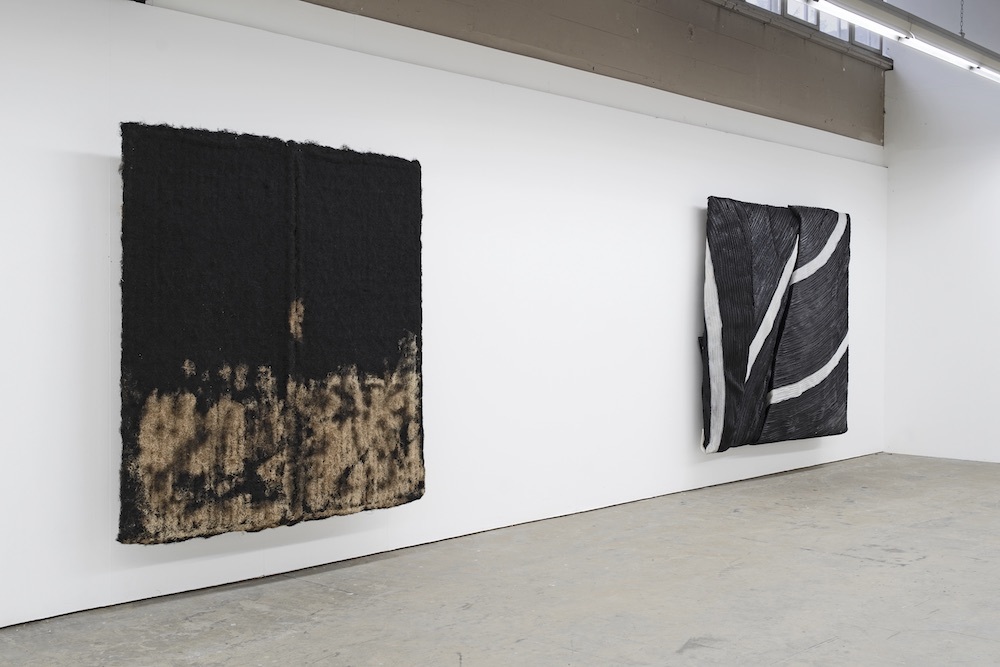
A mattress accompanies people in intimate situations such as sleeping, dreaming, sweating or even death. Everyone deserves their own mattress, believes Dorian Sari (b. 1989 in Izmir, lives and works in Basel and Geneva). The Basel-based artist is an observer of politics, social movements and emotions. For his work Bleaching, 2018, he reveals the inner workings of a 90-centimetre mattress which he found on the street and stitched together on its long edge. He then bleached the black filling material found inside – in part in response to a documentary on ‘skin bleaching’ in African countries. Lightening the skin is a trend among black women; they pursue a lighter skin by using illegal ‘skin bleaching’ creams, generally to the detriment of their health. By making the material lighter Dorian Sari’s sculpture appears like an abstract painting in which the mattress interior serves as a canvas. For the work Curvy, on the other hand, Sari used epoxy resin and zips. The ritual of quiet sewing within the production process enables the artist to release his observations into particular materials. If zips intrinsically mean opening and closing, Sari nullifies this function by fixing them forever with resin. What is more, there is nothing behind it – only a structure that reminds us of the frame of a canvas. (IT)

In her work the Basel-based artist Angelika Schori (b. 1981 in Biel / Bienne, lives and works in Basel) handles the terms painting, sculpture and drawing equally. Graphic forms pull away from surfaces and thus the image leaves the wall. Her objects begin to absorb space and open up new dimensions. At the same time some of her works ‘paint’ their own pictures, when the colours which Schori has applied to the back of the metal plates on these works throw colour on the wall beyond. Through the colour’s reflection on the white wall an independent painting is generated without the direct application of paint. By using clear forms, lines and colours Angelika Schori finds a way to transfer the fundamentals of drawing and painting into sculpture. A precise engagement with space can also be sensed in her site-specific works, in which the reversal of the space, or viewing from another perspective are central. Her works give the viewer pause to consider their perception of space and perspective and they invite us to fall under the spell of the soft play on colour and form. (KF)
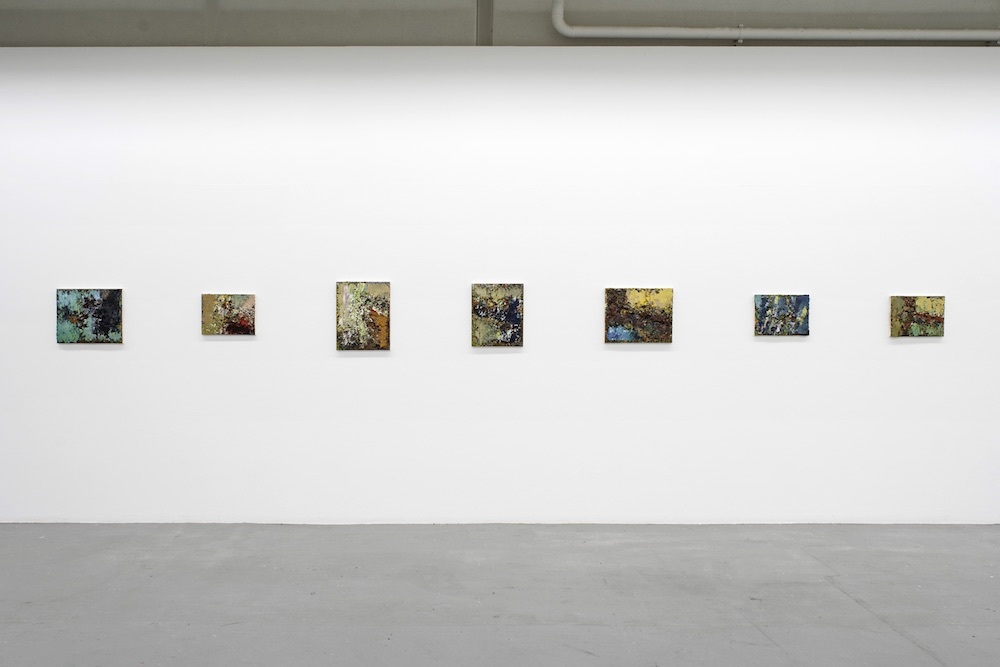
From the moment you step into the studio, it’s clear: this is about painting. Squeezed-out paint tubes pile up in heaps and the smell of oil paint is inescapable. Bruno Seitz (b. 1955 in Solothurn, lives and works in Basel) needs a lot of oil for his paintings, a great deal, even for the small-format works that are hardly wider than 50 centimetres. If from afar the works seem like pastose, abstract paintings with possible echoes of landscapes or art-historical quotations, the picture is different close up. There, craters of colour open up to reveal the countless layers of colour piled up onto and underneath one another. The points of rupture and fissures tell of a painting process in which daring, failure and new beginnings are inherent. Smeared, applied with a palette knife in time-consuming processes, dried through on not, with these Seitz has endeavoured for several decades to demonstrate that painting can be something other than oil on canvas. This negotiation of controlled application, allowing emotions to flow in a continuous and ongoing vis-à-vis with the canvas can also produce sculptural, immersive works. Our eyes become archaeologists that dig, discover and lose track. And may be astonished how profound painting can be today – in both senses of the word. (IG)
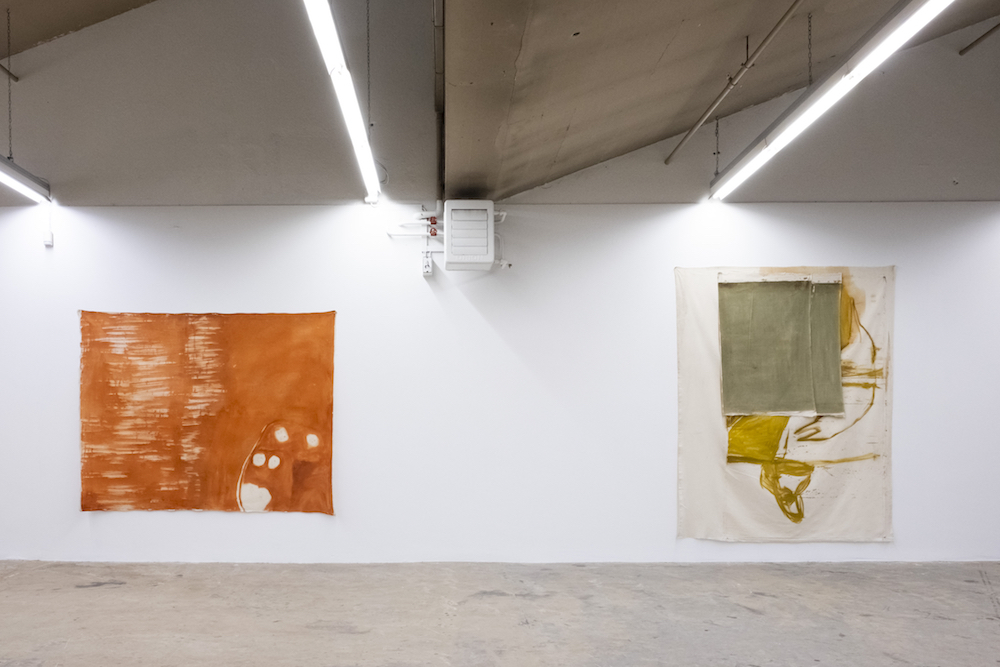
‘Abstract painting’ is a term that only begins to describe the work of Vivian Suter (b. 1949 Buenos Aires, lives and works in Guatemala), who has close connections to Basel. In recent months a newspaper headlined her practice ‘Radical in the Jungle’. That may seem irritating. So how can the correct term be found for painting like hers, which seems to absorb all realities, in a studio deep in the Guatemalan rainforest with a floor and ceiling, but few walls. Where landscape, weather and animals play as much a part as the artist herself. Vivian Suter’s unstretched canvases are generally worked over with large, gestural brushstrokes and acrylic paint, left out in the elements, carried through the landscape, dried and painted further. The deposits of time and personal painting can be found on these canvases, which may be clearly delineated on a stretcher, or may hang freely from wall or ceiling. Abstract, yes, but equally real, so real that all that is present in the moment of making remains an essential part of the work and writes itself into the work’s future. (IG)
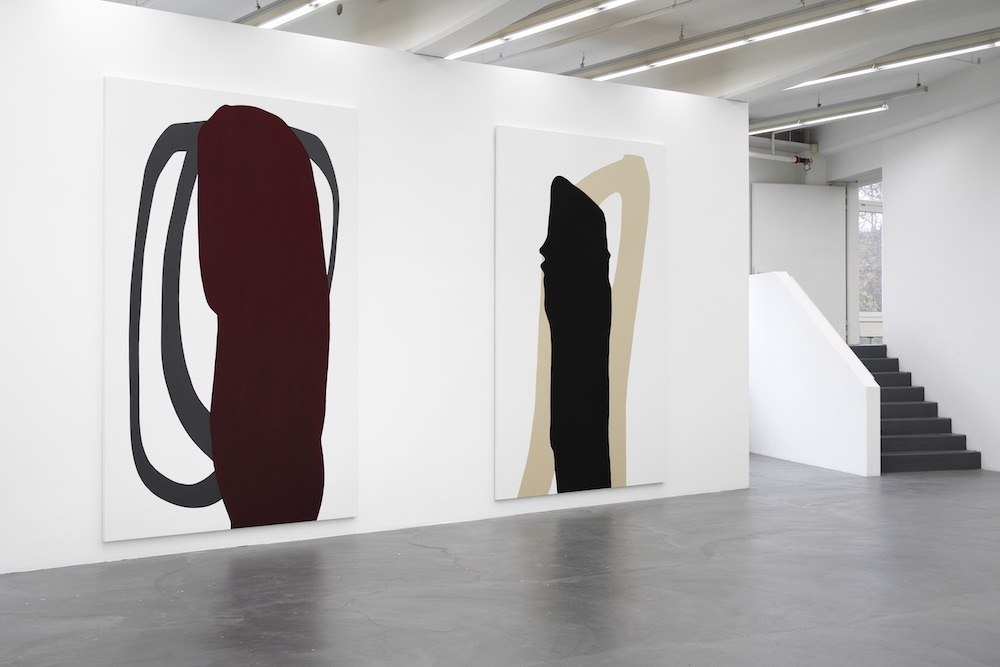
The powerful, large scale formats that Markus Weggenmann (b. 1953 in Singen, lives and works in Zurich) has boldly used in his work for decades usually begin very small. Sometimes they are A3 pages on which he allows compositions to emerge with swift brush strokes, loosely and without preliminary drawings. Colour and form combinations are spontaneously placed on the page, developed, discarded and returned to. In this manner an astonishing archive of pictures has developed. In a second stage, individual images are drawn from this and transferred precisely to large format stretchers – up to three metres – lying flat, with matt, only loosely combined pure pigment. The current series of works, which Weggenmann describes as ‘flat sculptures’, are formations which may remind viewers of monuments, steles or stone formations, or also generate associations with tall, prominent heads. Yet it is not this abstract vocabulary of form which drives the artist to create new works, primarily, but his interest in the question of painting’s presence and effect, and how painting can take hold of space and seem to transform it. (IG)
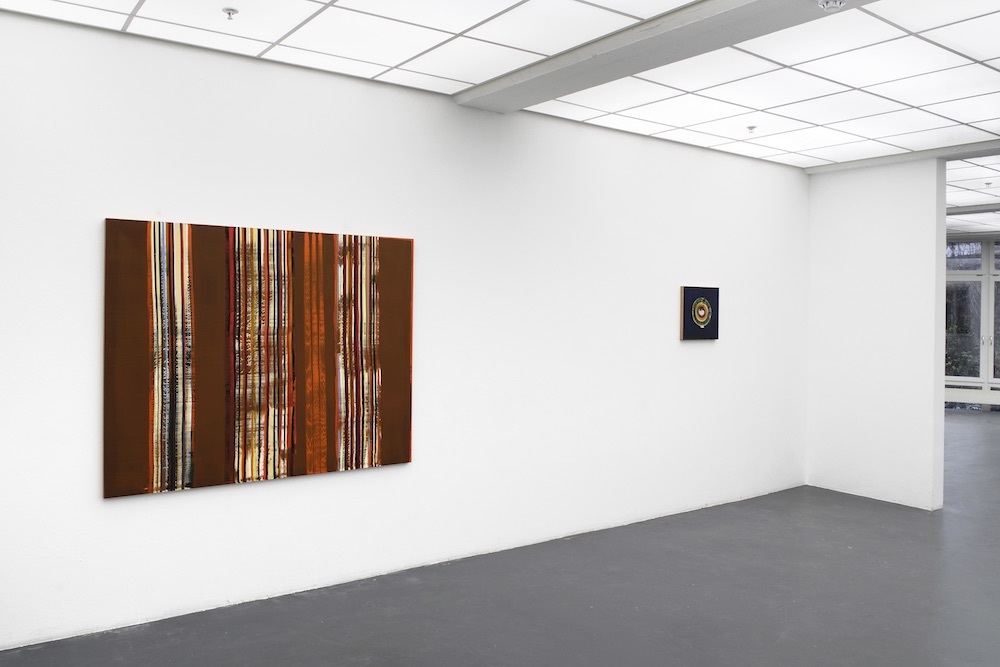
Well-travelled Basel artist Maria Magdalena Z’Graggen (b. 1958 in Basel, lives and works in Basel) uses paint as a living medium. Given its impasto quality it is, for the artist, a sometimes malleable and sometimes uncontrollable interlocutor. It offers possibilities and demonstrates borders which are continually renegotiated in the working process. The two work groups shown here, TERRA and The Fools come from sounding out these boundaries. While both series formally share gleeful unity, they emerge from distinct creative processes. The TERRA series is the result of a process that is planned in detail and carried out in a highly concentrated manner. The oil colours, in tones which the artist generates through the careful combination of pigments from across the globe, are applied to a smooth board in countless layers and paintings with great depth and luminosity come into being. Z’Graggen creates The Fools in parallel – a series of small-scale, spontaneous works on canvas, jesting reflections which playfully challenge the earnestness of painting. (CA)
Texts by Carole Ackermann, Klarissa Flückiger, Ines Goldbach and Ines Tondar